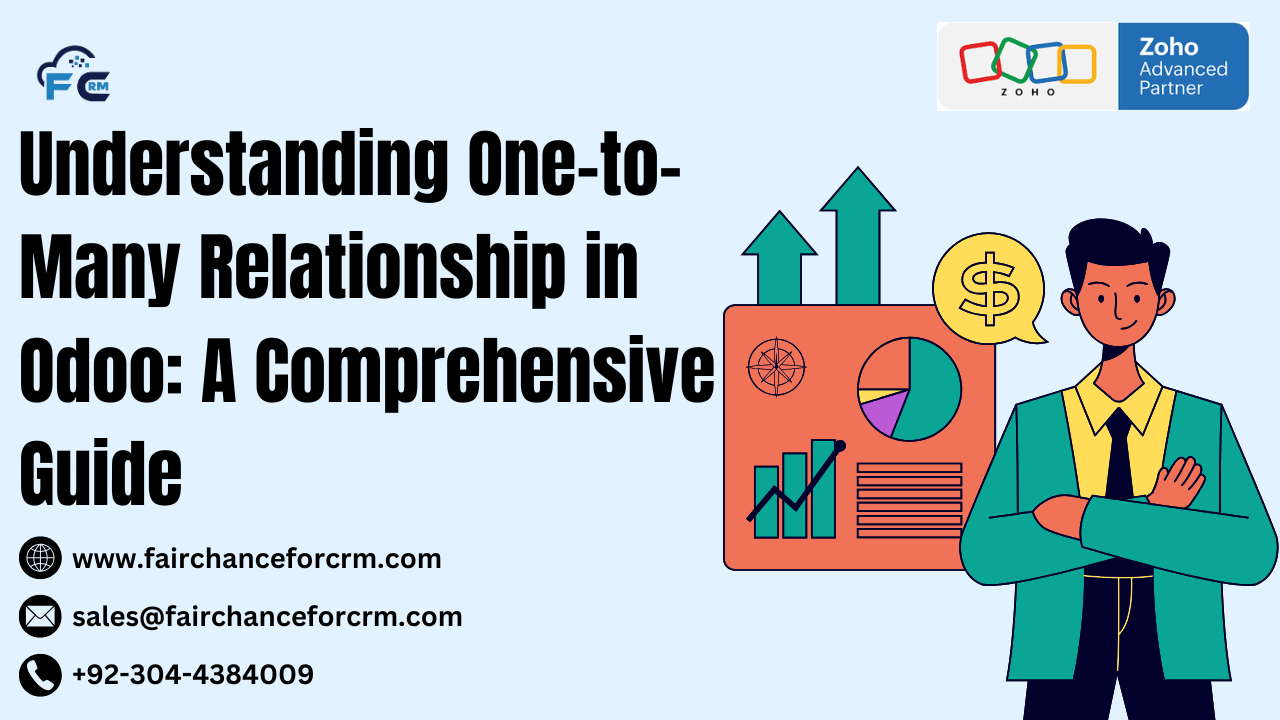Odoo is an open-source ERP platform that helps businesses streamline various operations like sales, accounting, inventory, and human resources. One of the fundamental aspects of managing relationships between data in Odoo is understanding how to model associations between different objects or records. One such relationship is the One-to-Many (1:N) relationship, which is crucial for managing data in a structured and efficient manner.
In this article, we will explore the concept of a One-to-Many relationship in Odoo, how it works, how to implement it, and how it benefits businesses using the platform.
Also Read:
- Odoo Backend: Features, Benefits, and Customization – Complete Guidance
- Mastering Odoo Route Management: A Comprehensive Guide
- How to Create and Manage a Gantt Chart View in Odoo 15: A Complete Guide
- Highrise CRM vs Zoho CRM – Complete Guidance
- Zoho Books API – Complete Guidance
What is a One-to-Many Relationship in Odoo?
A One-to-Many relationship (often referred to as 1:N) is a type of data relationship where one record in a model (table) can be associated with multiple records in another model. However, the reverse is not true—many records in the second model can only be associated with one record in the first model.
For example, in a sales scenario:
- One customer can have multiple sales orders.
- One product can be included in multiple sales orders.
Here, the Customer model is linked to the Sales Order model in a One-to-Many relationship, meaning that each customer can have many sales orders, but each sales order is associated with only one customer.
How Does One-to-Many Work in Odoo?
Odoo models use relational fields to create associations between records. To implement a One-to-Many relationship, Odoo uses a Many2one field in the related model (the “many” side) and a One2many field in the parent model (the “one” side).
1. Many2one Field
- A Many2one field is used on the “many” side of the relationship. It represents a foreign key in the related model that points to the parent model.
- For example, in the Sales Order model, the Customer field would be a Many2one field because each sales order refers to only one customer.
2. One2many Field
- The One2many field is placed on the parent model and represents the One-to-Many relationship. It allows the parent record to access the multiple related records.
- For example, in the Customer model, the Sales Orders field would be a One2many field. This field shows all the sales orders associated with that customer.
The relationship is automatically established through the database by the Many2one field that links the records on the “many” side back to the parent model.
Example: One-to-Many Relationship in Odoo
To better understand this relationship, let’s look at an example using the Sales Order and Customer models:
Step 1: Define the Models
In Odoo, models are defined using Python. Let’s create the models for Customer and Sales Order with a One-to-Many relationship.
- In the ResPartner model (Customer), we define a One2many field named
sales_order_idswhich will hold all the related sales orders. - In the SaleOrder model (Sales Order), we define a Many2one field named
partner_idwhich links back to the ResPartner model.
Step 2: Define the Relationship in Odoo Views
Once you’ve set up the models, you can define the relationship in Odoo’s views, allowing users to interact with the One-to-Many Relationship in Odoo through the UI.
In Odoo, views are typically defined using XML. Here’s how you can set up the views for the Customer and Sales Order models to show the One-to-Many relationship:
- In the Customer form view, the
sales_order_idsfield is displayed as a tree (list) of related sales orders. - In the Sales Order form, the
partner_idfield links to the related customer.
Benefits of One-to-Many Relationship in Odoo
1. Data Structuring
One-to-Many relationships help structure your data in a way that reflects real-world business processes. It ensures data integrity and avoids redundancy by linking records to their parent models.
2. Better Data Management
With One-to-Many relationships, you can easily track and manage multiple related records. For example, when viewing a customer’s profile, you can quickly access all the sales orders associated with that customer.
3. Improved Reporting
One-to-Many Relationship in Odoo are crucial for generating comprehensive reports. By linking models together, businesses can analyze data from various perspectives, such as customer performance, sales trends, or inventory levels.
4. Ease of Navigation
Using One-to-Many Relationship in Odoo improves navigation in the system. Users can seamlessly switch between related records. For example, from the customer record, users can directly access all related sales orders, making the system more intuitive.
5. Flexibility in Customization
The One-to-Many Relationship in Odoo can be customized based on business needs. You can adjust the relationship to link other models or create custom fields and actions that interact with these relationships.
Conclusion
The One-to-Many relationship is a key feature in Odoo that helps businesses structure their data effectively. It facilitates a clear, orderly manner to link information, such as matching several sales orders with a single customer, and enables more effective data administration and reporting. Businesses may increase operational efficiency and make better data-driven decisions by utilizing Odoo’s One-to-Many Relationship feature.
The One-to-Many connection is a crucial tool for any Odoo user since it can be tailored to meet different business processes and workflows thanks to the framework’s flexibility and customization. Whether you’re a developer building custom modules or a business user managing data, understanding how to implement and work with One-to-Many relationships in Odoo is key to maximizing the potential of this powerful ERP system.
For more information about the Understanding One-to-Many Relationship in Odoo: visit this link.
If you want to Free Trail Zoho, click on this link.




